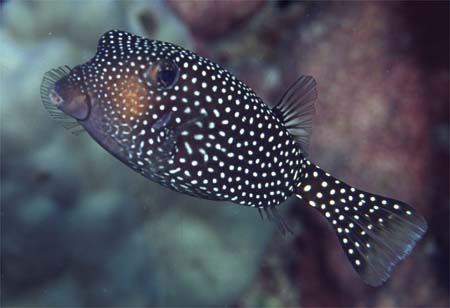SPOTTED BOXFISH · moa
Ostracion meleagris Shaw & Nodder, 1796
This is Hawai`i’s most common boxfish. Females are blackish brown densely covered on all sides with small white spots. Males have dark blue sides with irregular black spots, some of which may have gold centers. They also have gold markings on the head and at the base of the tail. Juveniles with male coloration are never seen, so either immature males have the female color pattern, or all juveniles are female with some changing sex later in life. Spotted Boxfish live in small haremic groups–typically one male to several females–and forage alone within their home ranges for sponges, worms, tunicates and other small bottom-dwelling invertebrates. Males defend territories against other males. These fish often poke around in the shallows where waders and people walking along shore can see them.The species name means “guineafowl” (a bird native to Africa covered with light spots). To about 6 in. Indo-Pacific and Eastern Pacific.
A subspecies or not?
 Outside Hawaiian waters the black spots on the sides of male Spotted Boxfish contain conspicuous bright gold centers. Also, there is a fused line of gold spots along the upper “corner” of the box. Because most Hawaiian males lack these gold spots, the Hawaiian population has long been given the subspecies name camurum. However, males with scattered gold-centered spots on the sides do occur here, and a few individuals display enough spots to almost resemble males found elsewhere in the Indo-Pacific. There is no doubt that the Hawaiian population is different, but given the presence of intergrades, is subspecies status justified? DNA analysis may someday clarify the situation. However, the concept of a subspecies is not currently in favor, so if the DNA folks decide that the Hawaiian population is sufficiently different, Hawaiian fish would likely be considered a full species with the name Ostracion camurum.
Outside Hawaiian waters the black spots on the sides of male Spotted Boxfish contain conspicuous bright gold centers. Also, there is a fused line of gold spots along the upper “corner” of the box. Because most Hawaiian males lack these gold spots, the Hawaiian population has long been given the subspecies name camurum. However, males with scattered gold-centered spots on the sides do occur here, and a few individuals display enough spots to almost resemble males found elsewhere in the Indo-Pacific. There is no doubt that the Hawaiian population is different, but given the presence of intergrades, is subspecies status justified? DNA analysis may someday clarify the situation. However, the concept of a subspecies is not currently in favor, so if the DNA folks decide that the Hawaiian population is sufficiently different, Hawaiian fish would likely be considered a full species with the name Ostracion camurum.

